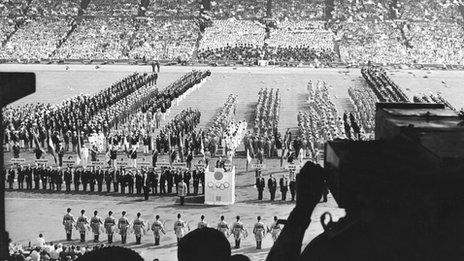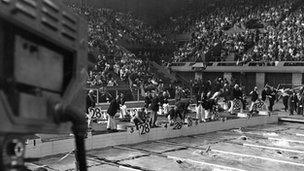London 2012: Olympics in 1948 dubbed TV 'milestone'
- Published

A BBC TV camera captured the release of 7,000 pigeons at the opening ceremony in the Empire Stadium
Billions of television viewers worldwide are expected to watch the 2012 Olympics in an era of many channels, the internet and the red button.
But back in 1948 there was just one button - the BBC was the only TV channel available when London last hosted the Games.
And with many people not able to have a TV set, turning to radio and newspapers was their only option.
Television expert Norman Green said there may have been only 100,000 sets in circulation at the time, with the vast majority in the Greater London area.
Those viewers were able to enjoy an average of four hours a day from the Wembley complex, in what was "a major milestone" for the BBC, representing what was then the largest operation in British broadcasting, Mr Green explained.
'Extremely good'
"There were newspaper reviews [of the output]," said Mr Green, who has given Royal Television Society lectures in London, Birmingham and Reading about the 1948 Games.
"Quite frankly people thought it was extremely good coverage."

Cameras were at the men's 1500m freestyle final at the Empire Pool
The broadcasts, however, came more than a decade since the BBC deployed its first television mobile control room - for the coronation of King George VI in May 1937. The Wimbledon tennis championship was first televised that summer as well.
When the 1948 Olympics began, though, weekday TV was still very limited - with previews and the test card between 1100 and 1200, an OB or a cinema film from 1500 to 1600 and programmes from the BBC's Alexandra Palace between 2030 and 2200.
While controversial football incidents are now replayed from many angles, there were only two cameras following the sporting action at each of the two outside broadcast (OB) units at the Games.
One unit was at the original Wembley stadium known as the Empire Stadium, where a pre-World War II OB van with TV screens had no seats for people to work.
There were no computer graphics, so a third camera at the stadium - and at the second OB unit at the Empire Pool nearby - was used to capture captions and still images of photo finishes.
In the Radio Times, viewers were told they would "have the opportunity of seeing the Opening Ceremony, the athletics, the boxing, the swimming, the diving, the football, the hockey, the riding and the Closing Ceremony".
"Television Newsreel will enable evening viewers to see something of the events like rowing, shooting, cycling and yachting, which are taking place at centres other than Wembley," the magazine added.
At the time, BBC TV had 14 commentators, with the likes of Richard Dimbleby and Peter Dimmock in the limelight.

The main television control room was at the Palace of Arts complex
But behind the scenes a temporary complex, that featured 16 sound studios and two television control rooms, was established at the Palace of Arts.
Television output was very different to the scale of the radio coverage, illustrated with BBC radio using 146 reporters covering 41 languages and there were 134 visiting radio reporters from 28 countries.
A total of 350 engineers and 200 support workers were among staff based at the Palace of Arts and the workers included many women, Mr Green said.
"A lot of BBC men were called up for national service in the war," said Mr Green.
"Women took their places, so they were still working at Broadcasting House when the Olympics [came]."
The most important part of the coverage came towards the end of the Games, on 12 August, when the BBC had eight hours of continuous live TV for the first time - helped by showing a play and deploying three mobile units at once, two at Wembley and one at White City.
But out of more than 68 hours of television the corporation produced, only 43 seconds of black and white images, showing the opening ceremony, represents the only available footage of the live 1948 Olympics TV coverage, Mr Green said.
The former ITV technology chief said: "They were experimenting with what we're calling telerecording... In those days there was no method of recording pictures."
- Published18 June 2012
- Published18 May 2011
- Published16 May 2012
- Published26 July 2010